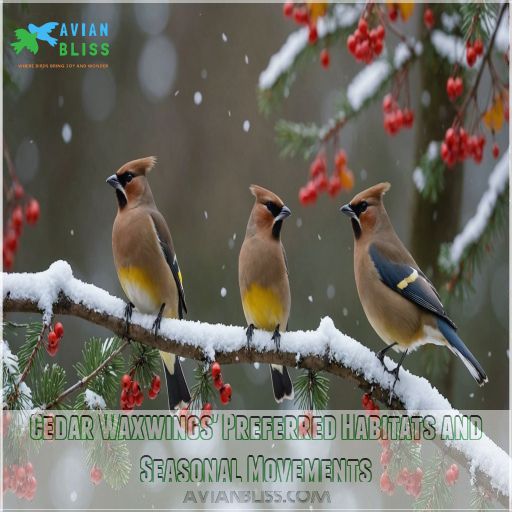This site is supported by our readers. We may earn a commission, at no cost to you, if you purchase through links.
 Want to attract cedar waxwings to your backyard? Start by planting native berry-producing shrubs and fruit trees, like serviceberry and dogwood—think of it as their personal buffet.
Want to attract cedar waxwings to your backyard? Start by planting native berry-producing shrubs and fruit trees, like serviceberry and dogwood—think of it as their personal buffet.
Keep a fresh water source ready, whether it’s a bird bath or a small fountain. Also, toss in some dried fruits and mealworms during their migration seasons.
These social birds love a crowd, so don’t be surprised if they show up in flocks, gossiping with thin cries. Who knew gardening could be this rewarding?
And if you’re curious about creating a bird paradise, there’s plenty more to explore on habitat creation.
Table Of Contents
- Key Takeaways
- Cedar Waxwing Identification: Key Features and Behaviors
- Cedar Waxwings’ Preferred Habitats and Seasonal Movements
- Fruit-bearing Plants That Attract Cedar Waxwings
- Creating a Water Source for Cedar Waxwings
- Feeding Strategies to Lure Cedar Waxwings
- Landscaping Your Yard for Cedar Waxwings
- Cedar Waxwing Nesting Habits and Support
- Seasonal Strategies for Attracting Cedar Waxwings
- Coexisting With Cedar Waxwings in Urban Settings
- Observing and Photographing Cedar Waxwings
- Frequently Asked Questions (FAQs)
- How do I attract cedar waxwings?
- Where do cedar waxwings live?
- Are cedar waxwings attracted to feeders?
- How do you attract cedar waxwings to a bird bath?
- Will Cedar Waxwings come to feeders?
- What time of day are Cedar Waxwings most active?
- Where do Cedar Waxwings hang out?
- Is it rare to see a Cedar Waxwing?
- How can I tell if cedar waxwings are visiting my yard?
- What time of year are cedar waxwings most likely to appear?
- Do cedar waxwings require specific nesting materials?
- How can I protect cedar waxwings from predators?
- Are there any unique behaviors I should watch for in cedar waxwings?
- Conclusion
Key Takeaways
- Plant native berry-producing shrubs and fruit trees, such as serviceberry and dogwood, to create a natural buffet that cedar waxwings can’t resist. Think of it as laying out a banquet that keeps these birds flocking back for more.
- Set up a birdbath or small fountain as a reliable watering hole. It’s like offering a cool drink on a hot day; with a bit of moving water, you’ll have cedar waxwings lining up for their spa day.
- Offer dried fruits and mealworms in open feeders to appeal to the waxwings’ sweet tooth. With these tasty treats, your yard becomes an all-you-can-eat buffet for these feathered guests.
- Balance open spaces with dense cover using multi-layered vegetation to provide cedar waxwings a safe spot for foraging and nesting. It’s like creating a cozy neighborhood that caters to their need for both food and protection.
Cedar Waxwing Identification: Key Features and Behaviors
You’ll spot cedar waxwings by their striking black mask, sleek crest, and yellow-tipped tail – they’re nature’s masked bandits, but they’re after fruit, not loot.
These social birds often travel in chatty flocks, passing berries to each other like they’re playing an avian version of hot potato.
Distinctive Black Mask and Crest
Imagine this: a bird so dapper, it looks like it’s wearing a superhero mask to a fancy dinner party.
That’s your cedar waxwing! Their distinctive black mask and sleek crest aren’t just for show – they’re nature’s way of saying, "I’m one cool customer."
These features help waxwings blend in with shadows, making them stealthy fruit thieves in your backyard.
So, next time you spot one, give a nod to nature’s masked marvels!
Yellow-tipped Tail and Waxy Wingtips
Now that you’ve spotted the black mask, let’s talk about the cedar waxwing’s showstopping features: its yellow-tipped tail and waxy wingtips. These aren’t just for show – they’re nature’s bling with a purpose!
The yellow tail tip evolved as a signal to other birds, while those red waxy wing tips? They’re thought to be courtship ornaments .
- A flash of yellow in flight, like a miniature sunset
- Red droplets on wings, resembling melted wax
- Silky feathers that shimmer in the sunlight
- Subtle color variations that make each bird unique
- Wing tips that look like they’ve been dipped in sealing wax
Size Comparison to Other Birds
A feathered puzzle awaits in your backyard!
Cedar waxwings are medium-sized birds, about 6 inches long and weighing an ounce. They’re similar in size to a large sparrow but smaller than American robins.
You’ll find them nestled between bluebirds and woodpeckers on the size spectrum.
Don’t let their compact frame fool you—these berry bandits can hold their own against larger birds, like a nimble running back facing a burly defensive tackle.
Social Behavior and Flocking Patterns
Camaraderie defines cedar waxwings, as they’re rarely seen solo. You’ll spot these social butterflies in flocks of 40 or more, swooping into berry-laden trees like feathered flash mobs.
They’re the ultimate team players, foraging together and communicating with thin, lisping cries. They use these vocalizations, along with visual signals like puffing up feathers, to convey messages and maintain their tight-knit groups.
During migration, they become nomadic, their flocking patterns shifting with food availability. It’s like they’re always throwing a berry-themed party, and you’re invited to watch!
Unique Fruit-passing Courtship Ritual
While you’re watching cedar waxwings, you might witness their charming berry-sharing courtship dance.
These lovebirds pass fruit back and forth, strengthening their mating bond. It’s like a birdie version of "Lady and the Tramp"!
This ritual showcases the waxwings’ unique diet and evolutionary adaptations.
To capture this magical moment, ready your camera and patience – you’ll be rewarded with a heartwarming display of avian affection.
Cedar Waxwings’ Preferred Habitats and Seasonal Movements
You’ve mastered spotting these dapper birds, but where can you find them? Cedar waxwings are nature’s nomads, always on the move in search of their next fruity feast. Their preferred habitats are as varied as their diet, which includes a variety of insects like beetles, caterpillars, and ants Cedar Waxwing Diet, in addition to berries.
They thrive in different climates and nesting sites based on factors like fruit availability and breeding success.
- Open woodlands with a smorgasbord of berries
- Riparian areas buzzing with aquatic insects
- Suburban gardens boasting ornamental fruit trees
These social butterflies of the bird world don’t stick to one place for long. In winter, they’ll grace your backyard with their presence if you’ve got the right food sources. Come breeding season, they’re off to more secluded spots, often near water. Their migration patterns are as unpredictable as a game of musical chairs – they’ll go wherever the berries are ripest.
So, if you want to be the coolest host on the block for these feathered party-goers, keep your garden stocked with a year-round buffet of fruits and watch the waxwings flock in!
Fruit-bearing Plants That Attract Cedar Waxwings
You’re about to become a berry buffet maestro for cedar waxwings.
With the right fruit-bearing plants in your yard, you’ll transform it into a waxwing wonderland that’ll have these masked marauders flocking to feast.
Native Berry-producing Shrubs
Ready to turn your garden into a waxwing wonderland? Native berry-producing shrubs are your secret weapon.
Plant a diverse mix like serviceberry, chokeberry, and beautyberry to create a year-round buffet (Source). These shrubs don’t just look pretty; they’re bird magnets!
Imagine the thrill of watching cedar waxwings flock to your yard, passing berries beak-to-beak in their quirky courtship dance. It’s like hosting nature’s own cocktail party!
Fruit Trees for Waxwing Attraction
For a fruity feast that’ll have cedar waxwings flocking to your yard, plant a buffet of their favorite trees. Serviceberries are like waxwing magnets – once you plant them, these birds will somehow sniff them out.
Don’t forget cherries, mulberries, and dogwoods for a varied menu.
Plant in spring for best results, and keep your trees healthy with regular pruning and watering. You’ll be rewarded with a lively waxwing party come harvest time!
Flowering Plants With Edible Seeds
Create a feast for cedar waxwings by planting flowering beauties with edible seeds.
Serviceberries are like an all-you-can-eat buffet for these masked bandits – plant them, and they’ll swoop in like magic.
Mix it up with viburnums and winterberries to create a berry bonanza .
You’ll be rewarded with a flurry of feathered activity, as waxwings and their bird buddies flock to your yard for a seedy smorgasbord.
Year-round Food Sources for Waxwings
Throughout the year, you can roll out the red carpet for cedar waxwings with a smorgasbord of fruity delights.
In spring, these feathered foodies feast on leftover winter berries and tree buds. Summer brings a bounty of strawberries, cherries, and raspberries.
Come fall and winter, they’ll gobble up dogwood berries, grapes, and even mountain ash fruits. Don’t forget the trusty serviceberry – it’s like catnip for waxwings!
Their eating habits can be easily satisfied with the right fruits, making them feathered foodies that can be attracted to your yard throughout the year.
Planting Strategies for Maximum Appeal
Now that you’ve got year-round food sources covered, let’s imagine a berry buffet that’ll make these sleek birds swoon!
Start by planting native showstoppers like serviceberry, dogwood, and juniper.
Mix it up with different fruiting times to keep the waxwings coming back for more.
Remember, variety is the spice of life – and the key to a waxwing wonderland!
Creating a Water Source for Cedar Waxwings
You’ll be amazed at how a well-placed water source can turn your yard into a cedar waxwing hotspot.
From birdbaths to fountains, creating the perfect watering hole for these social birds is easier than you might think, and it’ll have them flocking to your garden faster than you can say "berry bonanza.
Types of Bird Baths and Fountains
While fruit-bearing plants are a feast for Cedar Waxwings, don’t forget to quench their thirst.
A well-chosen bird bath or fountain can turn your yard into a waxwing watering hole. You’ll find a variety of styles to suit your taste and budget:
- Solar bubblers for eco-friendly splashing
- Elegant tiered fountains for a touch of class
- Shallow basins with textured bottoms for easy bird footing
- Copper drippers that add a whimsical touch
Remember, moving water is like a siren song to birds!
Maintaining Clean and Fresh Water
You’ve picked the perfect bird bath, but keeping it pristine is key to attracting cedar waxwings, especially when maintaining a black red and white bird-friendly habitat
.
Think of it as a spa day for your feathered friends!
Scrub that basin with a vinegar solution (1 part vinegar, 9 parts water) once or twice a week. It’s like giving your bath a clean cleanse.
Daily water changes are a must – nobody likes a stale cocktail, and birds are no exception to a fresh environment.
Positioning Water Features for Waxwing Safety
Let’s talk about setting up your water feature for our feathered friends. Place your birdbath or fountain where waxwings can easily spot it, but not too close to dense shrubs where predators might lurk.
Aim for a depth of 1-2 inches – perfect for waxwings to sip without taking an unintended dip. To make sure the waxwings’ safety, consider placing the water feature in an area with natural shelter from wind and predators, such as near trees or bushes that provide protection.
Also, keep in mind the importance of window safety when positioning the water feature, placing it within 3 feet of windows or more than 10 feet away to prevent collisions. Remember, these social birds love to drink in groups, so a wider basin is ideal.
Adding Moving Water Elements
Now that you’ve got your water feature safely positioned, it’s time to make it irresistible to Cedar Waxwings.
Adding moving water elements is like rolling out the red carpet for these stylish birds.
A gentle bubbler or dripper can turn your bird bath into a waxwing hotspot .
The sound of trickling water is music to their ears, drawing them in from afar.
It’s like sending out a VIP invitation to the coolest bird party in town!
Feeding Strategies to Lure Cedar Waxwings
You’re about to become the ultimate cedar waxwing matchmaker with these clever feeding strategies.
From offering a smorgasbord of dried fruits to timing your feeder refills just right, you’ll soon have these masked beauties flocking to your yard like it’s an all-you-can-eat buffet.
Offering Dried Fruits in Open Feeders
Water’s great, but these berry-loving birds have a sweet tooth for dried fruits too!
Place raisins, chopped apples, or other dried fruits in open feeders to entice cedar waxwings. They’re known to devour half a pint of raisins in minutes.
Position feeders near trees for quick escapes.
Remember, waxwings are social butterflies – where one lands, others follow.
Keep the buffet stocked, and you’ll have a flock of these masked bandits raiding your yard in no time!
Providing Mealworms as Protein Source
Protein-packed mealworms can be a real game-changer for attracting Cedar Waxwings, especially during breeding season .
You’ll want to offer small to medium-sized mealworms, as these birds prefer insects they can easily snatch mid-flight.
Sprinkle a few on an open platform feeder or mix them with dried fruits for a tempting buffet.
Store extras in the fridge to keep your feathered friends coming back for more.
Remember, moderation is key!
Timing Feeder Offerings for Waxwing Visits
Timing is everything when it comes to attracting cedar waxwings.
These berry-loving birds follow a seasonal rhythm, so you’ll want to sync your feeder offerings with their migration patterns.
In late summer and early fall, stock up on their favorite fruits like blackberries and cherries.
As winter approaches, switch to dried fruits and raisins in platform feeders.
Keep an eye out for flocks passing through – they might just stop by for a feast!
Avoiding Competition With Other Bird Species
To attract Cedar Waxwings while avoiding competition with other bird species, set up open platform feeders offering raisins and chopped apples away from crowded seed feeders.
It’s like hosting a VIP fruit buffet just for them.
Place these feeders near berry-producing shrubs they love, like Eastern Red Cedars or mulberries, ensuring you’ve considered seasonal timing for peak visits.
Landscaping Your Yard for Cedar Waxwings
Transforming your yard into a cedar waxwing paradise isn’t rocket science; it’s about giving these social birds a cozy blend of native plants and layered greenery, similar to a bird-friendly habitat
.
By balancing open airy spots with dense cover, you’ll create a waxwing wonderland they simply can’t resist!
Creating Multi-layered Vegetation Structure
Imagine your yard as a cozy multi-level home for cedar waxwings.
Start by selecting native plants to create a layered canopy, blending trees, shrubs, and ground cover. This structure offers shade tolerance and creates seasonal interest.
Picture waxwings fluttering through each layer like a feathered ballet, happily munching on berries while enjoying their new nature-inspired playground .
Incorporating Native Plants for Waxwings
After creating layers of greenery, why not focus on adding native plants to attract waxwings naturally?
Follow this plant selection guide for waxwing-friendly landscaping:
- Serviceberry: A magnet for many birds, including waxwings.
- Dogwood: Offers seasonal berry production.
- Mountain Ash: Provides colorful fruit clusters.
- Black Hawthorn: Perfect for local wildlife.
Balancing Open Areas With Dense Cover
Striking the right balance between open spaces and dense cover is key for attracting cedar waxwings.
Create a mix of lush, shrubby areas and clearings to provide both nesting sites and safe foraging zones.
Incorporate native berry-producing plants that offer year-round food, and make sure there are ample landing spots near the cover.
Seasonal Considerations for Year-round Attraction
When dreaming of year-round cedar waxwing visits, think about planting seasonally diverse gardens.
In spring, plan for migration with blossoming trees. Aim for summer breeding success by adding dense foliage, while also considering the importance of visible and accessible food sources like those found in hummingbird-friendly gardens.
By incorporating a mix of flowers that attract hummingbirds, such as azaleas and petunias, you can create an inviting environment for various bird species.
Fall’s feast can include fruit-laden shrubs, while winter beckons with berries aplenty.
Remember, a reliable, year-round water source keeps waxwings chirping, no matter the weather! (Source)
Cedar Waxwing Nesting Habits and Support
To make your garden a bustling nursery for cedar waxwings, focus on creating safe and inviting nesting sites by providing materials like soft grasses and twigs.
While you’re at it, keep an eye out for sneaky predators and plan your yard maintenance to avoid causing drama during their nesting season.
Because nobody wants an interrupted baby shower!
Ideal Nesting Sites for Waxwings
Picture your yard as a haven for Cedar Waxwings by selecting tree species like maples and pines.
Aim for nest heights between 6 and 20 feet to mimic their preferred nest locations.
Choose spots on horizontal branches or forks to keep nests snug and assign the best nest predator protection—a real lifesaver for these berry aficionados!
Providing Nesting Materials
After finding the perfect spot, it’s time to think about materials for cedar waxwing nests.
Offer a variety to attract them:
- Natural fibers like grass, moss, and twigs
- Soft liners such as feathers and down
- Nest hygiene: keep materials clean and dry
- Nest box placement: secure spots shielded from harsh weather
This creates an inviting home!.
Protecting Nests From Predators
To keep cedar waxwing nests safe from predators, strategically plant thorny shrubs like hawthorn around nesting areas. Their natural defenses deter intruders.
For added habitat safety, place nests in dense trees at varying heights.
If you’re feeling crafty, consider human intervention by installing predator guards near potential nesting sites. This way, your feathered friends can thrive under your watchful eye, especially if you provide the right food and shelter like native plants
.
Timing Yard Maintenance Around Nesting Season
Think of your yard as a temporary bird hotel. Timing your yard care during their nesting season is key to bird safety and having them return.
Delay trimming trees and pruning shrubs from late June to August, giving Cedar Waxwings time to settle and raise their chicks without disturbances.
By creating a calm sanctuary, similar to keeping loud noises to a minimum, you can guarantee the birds have a peaceful environment to thrive in.
They’ll thank you for their peaceful, impact-free environment.
Seasonal Strategies for Attracting Cedar Waxwings
Attracting cedar waxwings requires a seasonal approach.
In spring, focus on providing early-blooming flowers and nesting materials.
In summer, offer a variety of ripe fruits.
In fall, stock up on their favorite berries to keep these social birds coming back all year round.
Spring Migration Attraction Techniques
Nesting support prepped, now entice cedar waxwings during spring migrations with early fruit and nectar sources.
Time your plantings perfectly; apple, cherry, and serviceberry blossoms will help.
Map your yard’s habitat to align with their travel patterns.
Picture these feathered visitors enjoying an avocado toast of berries, flying in for a fruity brunch during their skyward commute. They can enjoy this treat, almost like a fruity brunch.
Summer Breeding Season Considerations
After enticing waxwings with your spring migration hotspot, brace yourself for their summer antics.
During the breeding season, focus on prime nesting site selection to welcome these feathery architects.
Accommodate courtship behavior by ensuring trees and shrubs provide the perfect perch.
Keep an eye on nestling care and potential predator threats; after all, every brood size variation needs safeguarding.
Fall Fruit Abundance for Waxwings
Come autumn, your backyard can transform into a cedar waxwing paradise with the right fall fruit abundance.
Planting fruit trees and shrubs like dogwoods or junipers provides berries that waxwings adore during their migration for winter food, protected by using netting for garden protection
.
- Red clusters of juicy dogwood berries
- Deep blue juniper berries dusted with frost
- Golden fields of apples and cedar trees
Coexisting With Cedar Waxwings in Urban Settings
Even in urban jungles, you can savor the delight of hosting cedar waxwings by managing fruit tree harvests with care.
While keeping windows waxwing-friendly.
By educating neighbors and ensuring your urban oasis balances birds and pest control, you’ll make your space the neighborhood’s wildest hotspot.
Managing Fruit Tree Harvests
Balancing your fruit tree harvests with cedar waxwing visits can be a fruitful endeavor! Time your harvests just before peak ripeness to reduce waxwing damage. Consider sharing the bounty by allocating a portion for these feathered guests.
Here’s a handy table for planning:
| Action | Timing | Benefit |
|---|---|---|
| Early Harvest | Pre-ripe stage | Minimize waxwing damage |
| Shared Harvest | Community effort | Encourage crop sharing |
| Tree Protection | Netting use | Protect future harvest |
With these tactics, you’ll sip on the sweet victory of cooperation!
Reducing Window Collisions
Picking your fruit harvest is rewarding, but preventing window collisions is equally important for our feathered visitors.
Try these tips:
- Apply window film for an invisible barrier.
- Use bird-safe glass to protect without compromising views.
- Install reflective decals; they’re like traffic signs for birds.
- Enhance landscaping around windows as a natural deterrent.
Make your home a safe haven!
Balancing Waxwing Attraction With Pest Control
While you want to attract waxwings, you’ll also need to manage pests in your fruit trees.
Try using waxwing-friendly pesticides and integrated pest management techniques that protect your harvest while preserving the birds’ food sources.
Encourage beneficial insects like ladybugs to naturally control aphids and other pests.
Educating Neighbors About Waxwing Benefits
Imagine this: your backyard, a haven for Cedar Waxwings, becomes a neighborhood sensation!
Educate your neighbors about their benefits through these tips:
- Share fun facts—these birds love berries and insects.
- Plant Waxwing-friendly landscaping with native shrubs.
- Host a bird-watching day to spark conservation interest.
Together, create an urban wildlife partnership that thrives!
Observing and Photographing Cedar Waxwings
Capturing the elegance of cedar waxwings in your photos can be as thrilling as a birdwatcher’s treasure hunt, and you’ll need the right settings to do them justice.
Remember to keep your approach gentle and respectful, because their striking black masks and berry-sharing antics aren’t to be missed!
Camera Settings for Capturing Waxwings
Want to snap the perfect waxwing shot? Set your camera’s shutter speed around 1/1000 of a second to freeze their swift movements.
Use ISO sensitivity of 400 to 800 for clear images without graininess. Choose a telephoto lens for detailed feathers.
In varied light conditions, adjust your settings; it’s like waxing poetic with photography!
Ethical Guidelines for Bird Photography
Capturing cedar waxwings in action is thrilling, but remember, snapping photos shouldn’t ruffle any feathers. Focus on camera ethics to guarantee bird welfare.
- Maintain a respectful distance to prevent wildlife disturbance.
- Use a telephoto lens to respect habitats.
- Share photos thoughtfully, always considering the impact on nature and the viewer’s perception.
Enjoy the moment ethically!
Participating in Citizen Science Projects
Once you’ve ethically snapped stunning photos of Cedar Waxwings, why not join a citizen science project?
It’s perfect for turning those sightings into valuable data.
Participate in Cedar Waxwing surveys, helping with Purple Finch behavior and species identification and habitat monitoring for finches like the Purple Finch Migration
.
Your observations can make a big impact, turning a hobby into a scientific contribution that benefits conservation efforts .
Frequently Asked Questions (FAQs)
How do I attract cedar waxwings?
To attract cedar waxwings, plant native berry-producing shrubs like dogwood, serviceberry, and juniper.
These fruits provide essential food.
Also, offer low-level bird baths for their enjoyment.
Watching them splash around can be quite entertaining!
Where do cedar waxwings live?
Cedar waxwings make their home in woodlands, forests, and suburban areas.
You might spot them around fruiting trees, streams, or even in gardens.
These birds are nomadic, settling wherever berries are plentiful.
Are cedar waxwings attracted to feeders?
Attracting cedar waxwings to feeders can be tricky,
but they might visit if you offer suitable foods like raisins or chopped apples in large, open platform or tray feeders where flocks can feel comfortable.
How do you attract cedar waxwings to a bird bath?
Your backyard will become irresistible if you offer Cedar Waxwings a bird bath just 2-3 inches deep, placed in a sunny spot.
A bubbler or wiggler adds motion, catching birds’ attention like a fish catches cats!
Will Cedar Waxwings come to feeders?
You mightn’t spot them at your feeders easily, but cedar waxwings can be drawn in with the right offerings.
Try platform feeders stocked with berries, chopped apples, and mealworms – they’ll flock to these tasty treats!
What time of day are Cedar Waxwings most active?
Cedar Waxwings are buzzing with energy in the early morning and late afternoon.
They flutter and feast on ripe berries.
They’re sociable, so look for them in flocks, transforming trees into lively banquet halls.
Where do Cedar Waxwings hang out?
Imagine thinking Cedar Waxwings only visit exotic locations.
They hang out in berry-laden areas, like orchards, shrublands, and suburban yards.
They are known for feasting in flocks, chit-chatting with lisping cries, and showcasing their aerial stunts.
Is it rare to see a Cedar Waxwing?
Spotting a Cedar Waxwing isn’t rare since these sociable birds love hanging out in flocks.
They can often be found in open woodlands or even suburban areas, where they feast on berries.
They’re often spotted passing berries beak-to-beak .
How can I tell if cedar waxwings are visiting my yard?
Picture a murmuration of graceful acrobats swirling in your trees.
You’ll know cedar waxwings are visiting by their high-pitched whistles and group feasting on berries.
Look for their sleek plumage and striking black masks.
What time of year are cedar waxwings most likely to appear?
Cedar Waxwings often appear in late winter and early spring, feasting on berries of trees like eastern red cedar and dogwoods.
Their nomadic nature means they might surprise you with their visits, especially when berries are plentiful.
Their visits are often unexpected, and this is especially true when berries are plentiful .
Do cedar waxwings require specific nesting materials?
You’ll find Cedar Waxwings need various materials like twigs, grasses, and cattail down for nests.
Females creatively weave these into a cup shape, sometimes even using silky tent caterpillar strands, adding a whimsical twist! (Source)
How can I protect cedar waxwings from predators?
You’re looking to protect those feathered friends, are you?
Well, don’t worry – with a few clever tricks, you can keep those pesky predators at bay.
Start by planting dense shrubs and installing bird feeders with squirrel-free access protected by baffles to create a safe haven for your waxwings
.
Are there any unique behaviors I should watch for in cedar waxwings?
Watch for waxwings passing berries back and forth like a tiny game of hot potato.
They’re social creatures, often seen fluttering in flocks and performing graceful aerial maneuvers, showing off impressive skill and coordination.
Conclusion
Drawing cedar waxwings to your yard is like crafting a living masterpiece—expressive, evolving, and rewarding.
With native berries, fresh water, and welcoming habitats, you’ll create a haven for these lively birds.
Consider the impact of shrubs, fountains, and seasonal plants, and soon you’ll enjoy their company and thin cries.
Take joy in understanding their behaviors and habitat needs.
How to attract cedar waxwings? Simply design your garden with love, patience, and a touch of whimsical charm.













